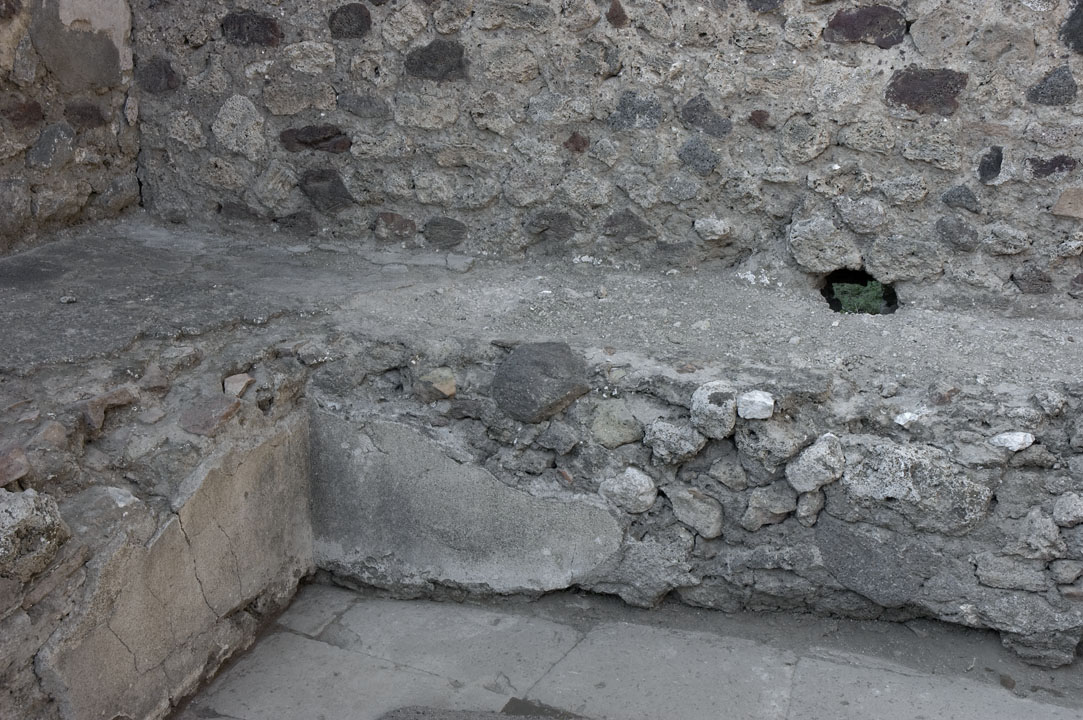Fountain
Description
Renée Forsell
Fountain/nymphaeum
The nymphaeum consists of a three benches placed along the E, N and W walls. The E bench slopes towards the S and ends more or less at floor level. The surfaces of the N and W benches are in the final stage horizontal. However, originally the W bench was also sloping towards S. When the aqueduct water was installed a lead water pipe, of which 0.10m is still visible in situ, was placed into the surface of the W bench and the surface was raised to a horizontal level. The water pipe continues in the N bench. It it can be seen surfacing for 0.15m at the centre of the bench, quite near the S edge, where marks in the edge shows that some kind of spout would have directed the water into the basin below.
The benches are built like heavily mortared rubble walls with a face of op. incertum consisting of limestone, cruma lava stones and spolia of roof tiles and other terracotta fragments. In the NE corner a large lava block is part of the upper surface. The surfaces of the E and N benches are generally poorly preserved while the W bench is in a somewhat better state of preservation where the inner N part is covered with lime mortar tempered with small pieces of lava. In the S part the surface is gone and instead we see the second phase filling, containing several large fragments of terracotta. The W bench is shorter then the E one, as its length has been defined by the already existing cistern. The bench is built on top of the cistern's lava rim, which shows that the benches were not part of the original set up of the room.
Remains of plaster are found on the sides of the benches, in the corner between the E and N benches as well as on the W bench where it continues on the N bench. The plaster on the E bench abuts to the floor of the basin. The lowest 0.12m has a reddish tint and there are traces of black above it. The side of W bench is to a large extent covered in plaster. There is also some plaster coating. Originally the faces of the benches were covered in white plaster towards the basin and above. This is most clearly seen in the S part of the W bench where some older plaster overlaps the edge of the original upper surface.
The basin is delimited In the W, N and E sides of the benches. Five cut blocks of lava stone create the S edge. Two of these are split in two. In front of the cistern, in the SW, another lava block form the edge. The floor consists of 18 grey tufa blocks of various sizes. The floor surface is uneven and some of the blocks have shallow cracks. A drainage hole is located inn the SW corner. From there the water would have filled the cistern and the overflow would continue through a drain under the threshold towards the atrium.
E Bench l. E 3.14m; W 2.22m; h. N 0.59m; S 0.15m; w. N 0.89m; S 0.88m
N Bench l. N 4.55m; S 2.68m; h. E 0.60m; W 0.62m; w. E 0.88m; W 0.84m
W Bench l. E 1.75m; W 2.53m; h. N 0.63m; S 0.59m; w. 1.00m. Original h. N 0.58m; S 0.31m.
Pipe visible at 2,11-2.26m from W wall, 0.48m from N wall.

